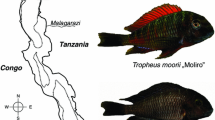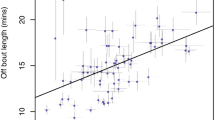Summary
Acanthemblemaria crockeri exhibits a resource defense polygyny mating system with male parental care. Females preferred to mate with the larger of two males in laboratory experiments, and male size was positively correlated with the number of eggs defended by males at two sites in the Gulf of California, Baja California, Mexico. Females appeared to avoid mating with males defending heavily-fouled shelters. The role of other factors including the intensity of male courtship coloration and displays in determining male reproductive success was studied in Bahia San Carlos, Sonora, Mexico by providing glass vials as shelters. This provided a non-destructive technique for counting of eggs defended by males and allowed repeated assessment of the reproductive success of individual males. Males varied greatly in their duration of residency of shelters and in their color score and intensity of courtship displays. The number of eggs received by males was positively correlated with their duration of residency in shelters, and females appeared to avoid mating with new residents. Mated males deserted shelters less frequently and were more likely to receive future matings than were unmated males. The mean color score of males was unrelated to their reproductive success, while the intensity of male courtship displays was negatively correlated with the number of eggs received. This may have resulted because female mate choice is based on multiple criteria, including some that more accurately reflect the quality of parental care afforded by males.
Similar content being viewed by others
References
Bastock M (1967) Courtship. An ethological study. Aldine, Chicago
Bateson PPG (ed) Mate choice. Cambridge Univ Press, New York
Brown L (1981) Patterns of female choice in mottled sculpins (Cottidae, Teleostei). Anim Behav 29:375–382
Burley N (1981) Mate choice by multiple criteria in a monogamous species. Am Nat 117:515–528
Cole KS (1982) Male reproductive behaviour and spawning success in a temperate zone goby, Coryphopterus nicholsi. Can J Zool 60:2309–2316
Darwin C (1871) The descent of man, and selection in relation to sex. Murray, London
Dominey WJ, Blumer LS (1984) Cannibalism of early life history stages in fishes. In: Hausfater G, Hrdy SB (eds) Infanticide: Comparative and evolutionary perspectives. Aldine, New York, pp 43–64
Emlen ST, Oring LW (1977) Ecology, sexual selection, and the evolution of mating systems. Science 197:215–223
Endler JA (1980) Natural selection on color patterns in Poecilia reticulata. Evolution 34:76–91
Endler JA (1983) Natural and sexual selection on color patterns in poeciliid fishes. Envir Biol Fish 9:173–190
Farr JA (1980) Social behavior patterns as determinants of reproductive success in the guppy, Poecilia reticulata Peters (Pisces: Poeciliidae). Behaviour 74:38–91
Haas R (1976) Sexual selection in Nothobranchius guentheri (Pisces: Cyprinodontidae). Evolution 30:614–622
Halliday TR (1983) The study of mate choice. In: Bateson PPG (ed) Mate choice. Cambridge Univ Press, New York, pp 3–32
Hastings PA (1984) Resource limitation in a coral-dwelling fish. Am Zool 24: 128 A
Hastings PA (1986) Habitat selection, sex ratio and sexual selection in Coralliozetus angelica (Blennioidea: Chaenopsidae). In: Uyeno T, Arai R, Taniuchi T, Matsuura K (eds) Indo-Pacific fish biology. Ichthyological Soc Japan, Tokyo, pp 785–793
Hastings PA (1987) Mating systems and mate choice in tube blennies (Blennioidea: Chaenopsidae). PhD Diss, Univ Arizona, Tucson
Hastings PA (1988) Female choice and male reproductive success in the angel blenny, Coralliozetus angelica (Teleostei: Chaenopsidae). Anim Behav 36:115–124
Jones GP (1981) Spawning-site choice by female Pseudolabrus celidotus (Pisces: Labridae) and its influence on the mating system. Bchav Ecol Sociobiol 8:129–142
Kodric-Brown A (1977) Reproductive success and the evolution of breeding territories in pupfish (Cyprinodon). Evolution 31:750–766
Kodric-Brown A (1983) Determinants of male reproductive success in pupfish (Cyprinodon pecosensis). Anim Behav 31:128–137
Kodric-Brown A (1985) Female preference and sexual selection for male coloration in the guppy (Poecilia reticulata). Behav Ecol Sociobiol 17:199–205
Kodric-Brown A, Brown JH (1984) Truth in advertising: the kinds of traits favored by sexual selection. Am Nat 124:309–323
Lindquist DG (1975) Comparative behavior and ecology of Gulf of California chaenopsid blennies. PhD Diss, Univ Arizona, Tucson
Lindquist DG (1980) Aspects of the polychromatism in populations of the Gulf of California browncheek blenny, Acanthemblemaria crockeri (Blennioidea: Chaenopsidae). Copeia 1980:137–141
Marconato A, Bisazza A (1986) Males whose nests contain eggs are preferred by female Cottus gobio L. (Pisces, Cottidae). Anim Behav 34:1580–1581
Noble GK (1938) Sexual selection among fishes. Biol Rev 13:133–158
Noonan KC (1983) Female mate choice in the cichlid fish Cichlasoma nigrofasciatum. Anim Behav 31:1005–1010
Perrone M Jr (1978) Mate size and breeding success in a monogamous cichlid fish. Envir Biol Fish 3:193–201
Petersen CW (1985) Mating systems in tropical marine fishes: theory and case studies of simultaneous hermaphroditism and parental care. PhD Diss, Univ Arizona, Tucson
Pyke GH (1984) Optimal foraging theory: a critical review. Ann Rev Ecol Syst 15:523–575
Ridley M, Rechten C (1981) Female sticklebacks prefer to spawn with males whose nests contain eggs. Behaviour 76:152–161
Rohwer S (1978) Parent cannibalism of offspring and egg raiding as a courtship strategy. Am Nat 112:429–440
Schmale MC (1981) Sexual selection and reproductive success in males of the bicolor damselfish, Eupomacentrus partitus (Pisces: Pomacentridae). Anim Behav 29:1172–1184
Searcy WA (1982) The evolutionary effects of mate selection Ann Rev Ecol Syst 13:57–85
Stephens JS Jr (1963) A revised classification of the blennioid fishes of the American family Chaenopsidae. Univ Calif Publ Zool 68:1–165
Thompson S (1986) Male spawning success and female choice in the mottled triplefin, Forsterygion varium (Pisces: Tripterygiidae). Anim Behav 34:580–589
Thornhill R, Alcock J (1983) The evolution of insect mating systems. Harvard Univ Press, Cambridge
Trivers RL (1972) Parental investment and sexual selection. In: Campbell B (ed) Sexual selection and the descent of man. Aldine, Chicago, pp 136–179
Williams GC (1966) Adaptation and natural selection. Princeton Univ Press, Princeton
Wittenberger JF (1984) Tactics of mate choice. In: Bateson PPG (ed) Mate choice. Cambridge Univ Press, New York, pp 435–447
Author information
Authors and Affiliations
Rights and permissions
About this article
Cite this article
Hastings, P.A. Correlates of male reproductive success in the browncheek blenny, Acanthemblemaria crockeri (Blennioidea: Chaenopsidae). Behav Ecol Sociobiol 22, 95–102 (1988). https://doi.org/10.1007/BF00303544
Received:
Accepted:
Issue Date:
DOI: https://doi.org/10.1007/BF00303544




